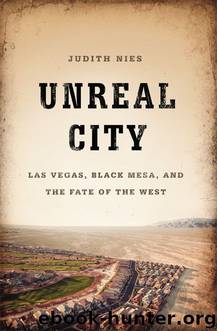Unreal City: Las Vegas, Black Mesa, and the Fate of the West by Nies Judith

Author:Nies, Judith [Nies, Judith]
Language: eng
Format: epub
ISBN: 9781568584874
Publisher: Nation Books
Published: 2014-04-08T00:00:00+00:00
THE GREAT DEPRESSION
Although Hoover Dam is generally believed to have been a great public works project of the New Deal administration during the Depression, it was actually a construction project built by private enterprise, funded by the government, and put in motion by the business-oriented Hoover administration to help the landowners of the Imperial Valley of Southern California. When the head of the Reclamation Bureau, Arthur Powell Davis, made his full report on the Colorado River to Congress, the report was officially titled “Report on Problems of Imperial Valley and Vicinity.”
What made the Hoover Dam project different from any other construction project that any of the partners had ever worked on was that the entire country was in the depths of the Great Depression. The economy was stagnant, and the cost of materials had been cut in half. Labor was limitless. With a national unemployment rate of 25 percent, one out of every four workers was unemployed. People were living in their cars. Families had lost homes, jobs, and their savings, and they needed everything—housing, health care, schools, jobs. By 1931, the year construction started, more than ten thousand unemployed workers from across the country converged on Las Vegas to fight for fifteen hundred jobs. Instead of the young miners they expected to hire, the Six Companies employment office in Las Vegas faced long lines of workers of every age and every background—some in three-piece suits—from all over the country. Many arrived with families and children and were living in tents or cars if they had them. They set up tent colonies along Boulder Highway and shanties adjacent to the federal reservation where workers were housed (actually, workers were also in tents because housing was still being built). The unemployed patiently waited for someone to die or be fired.
And during that first summer, as temperatures soared to more than 120 degrees and 130 degrees on the floor of Black Canyon and never went below 100 even at night, many did die. The medical teams did not know how to treat heat prostration or extreme dehydration. The stupefying heat was so relentless that workers could not replace the amount of water their bodies lost. Body temperatures went to 104 degrees, and workers went into comas. Even with the extreme summer heat, men tried to sneak into the dam site to ask for employment. Every worker had to have an official pass, or else they were turned away at the gate and told to apply at the main office in Las Vegas.
One desperate but resourceful unemployed father cut the small rectangular photo label off the front of his son’s cereal box because the design was similar to a worker’s identification pass. He hitched a ride down Boulder Highway to the job site with four employed workers and flashed the cereal-box cutout when the guard at the gate peered through the car windows and scanned their identification. The guard nodded and waved them all through. With a wife and four children, the youngest
Download
This site does not store any files on its server. We only index and link to content provided by other sites. Please contact the content providers to delete copyright contents if any and email us, we'll remove relevant links or contents immediately.
| Africa | Americas |
| Arctic & Antarctica | Asia |
| Australia & Oceania | Europe |
| Middle East | Russia |
| United States | World |
| Ancient Civilizations | Military |
| Historical Study & Educational Resources |
Cat's cradle by Kurt Vonnegut(14760)
Pimp by Iceberg Slim(13779)
Underground: A Human History of the Worlds Beneath Our Feet by Will Hunt(11839)
4 3 2 1: A Novel by Paul Auster(11791)
The Radium Girls by Kate Moore(11621)
Wiseguy by Nicholas Pileggi(5318)
American History Stories, Volume III (Yesterday's Classics) by Pratt Mara L(5136)
Perfect Rhythm by Jae(5072)
The Fire Next Time by James Baldwin(5017)
Paper Towns by Green John(4799)
Pale Blue Dot by Carl Sagan(4618)
A Higher Loyalty: Truth, Lies, and Leadership by James Comey(4551)
The Mayflower and the Pilgrims' New World by Nathaniel Philbrick(4281)
The Doomsday Machine by Daniel Ellsberg(4246)
Killers of the Flower Moon: The Osage Murders and the Birth of the FBI by David Grann(4189)
Too Much and Not the Mood by Durga Chew-Bose(4095)
The Sympathizer by Viet Thanh Nguyen(4095)
The Borden Murders by Sarah Miller(4019)
Sticky Fingers by Joe Hagan(3912)
